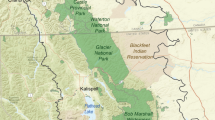Abstract
Ecological regionalization according to the USDA Forest Service National Hierarchical Framework of Ecological Units was undertaken for the New England-New York region. A topdown, map-overlay approach was used to map sections and subsections. Where available, landscape level units (LTAs) were aggregated and evaluated to supplement the subsection mapping. A regional collaborative effort was undertaken to counterbalance the shortfalls of a purely mechanistic approach. As a result of this process, 17 section and 58 draft subsection units were delineated for the New England-New York region. The sub-regional units developed reflect the strong correspondence among climate, topography and geography at this scale. Geologic factors, due to their influence on landform and mineral availability, are also reflected in the ecological unit boundaries. Efforts to apply the multifactor model at the sub-regional level have been hampered by the lack of scale appropriate information on a number of factors particularly meso-scale climate and potential natural community composition and distribution. Further research and investigation are required before these criterion are adequately met.
Similar content being viewed by others
References
AdamsC.C., BurnsG.P., HankinsonT.L., MooreB. and TaylorN.: 1920, ‘Plants and animals of Mount Marcy, New York, Parts I, II, and III’, Ecology 1, 71–94, 204–233, 274–288.
AlbertD.A., DentonS.D. and BarnesB.V.: 1986, ‘Regional landscape ecosystems of Michigan’, University of Michigan, School of Natural Resources, Ann Arbor, Michigan.
AversP.E., ClelandD.T., McNabW.H., JensenM.E., BaileyR.G., KingT., GoudeyC.B. and RussellW.E.: 1994, ‘National hierarchical framework of ecological units’, US Dep. Agric., For. Serv., Washington, DC, 15 pp.
BaileyR.G.: 1985, ‘Description of the ecoregions of the United States (2nd ed.)’, Miscell. Publ. No. 1391 (revised), US Dep. Agric., For. Serv., Washington, DC.
BaileyR.G., AversP.E., KingT. and McNabW.H. (eds.): 1994, ‘Ecoregions and subregions of the United States’, Map at 1:7 500 000 scale, US Geol. Surv., Washington, DC.
BrayW.L.: 1915, ‘The development of the vegetation of New York State’, Tech. Publ. No. 3, New York State College of Forestry, Syracuse, New York, 186 pp.
CogbillC.V. and WhiteP.S.: 1991, ‘The latitude-elevation relationship for spruce-fir forest and treeline along the Appalachian Mountain chain’, Vegetatio 94, 153–175.
DriscollR.S. and others: 1984, ‘An ecological land classification framework for the United States’, Misc. Publ. No. 1439, US Dep. Agric., For. Serv., Washington, DC, 56 pp.
FincherJ.M. and SmithM.L.: 1994, ‘A discriminant function approach to ecological site classification in northern New England’, Res. Pap. NE-686. US Dep. Agric., For. Serv., Durham, New Hampshire, 12 pp.
FosterD.R., ZebrykT.M.: 1993, ‘Long term vegetation dynamics and disturbance history of a Tsuga dominated forest in New England’, Ecology 74(4), 982–998.
GallantA., WhittierT.R., LarsenD.P., OmernikJ.M. and HughesR.M.: 1989, ‘Regionalization as a tool for managing environmental resources’, Rep. No. EPA/600 3-89/060, US Environ. Protect. Agency, Environ. Res. Lab., Corvallis, Oregon, 152 pp.
HazardH.E.: 1937, ‘Plant indicators of pure white pine sites in southern New Hampshire’, Journal of Forestry 35, 477–486.
HeimbergerG.C.: 1934, ‘Forest types studies in the Adirondack region’, Mem. No. 165, Cornell University, Agricultural Experiment Station, Ithaca, New York, 122 pp.
JensenM.C., McNicollC. and PratherM.: 1991, ‘Application of ecological classification to environmental effects analysis’, Journal of Environmental Quality 20, 24–30.
Jordan, J.K.: 1982, ‘Application of an integrated land classification’, In: Proceedings Artificial Regeneration of Conifers in the Upper Lakes Region, pp. 65–82.
KlijnF. and Udo de HaesH.A.: 1994, ‘A hierarchical approach to ecosystems and its implications for ecological land classification’, Landscape Ecology 9(2), 89–104.
LeakW.B.: 1982, ‘Habitat mapping and interpretation in New England’, Res. Pap. No. NE-496, US Dep. Agric., For. Serv., Broomall, Pennsylvannia, 28 pp.
LorimerC.G.: 1977, ‘The presettlement forest and natural disturbance cycle of northeastern maine’, Ecology 58, 139–148.
McNabW.H. and AversP.E., (eds.): 1994, ‘Ecological subregions of the United States, part one: sections’, Rep. No. WO-WSA-5, US Dep. Agric, For. Serv., Washington, DC, 337 pp.
NicholsG.E.: 1918, ‘The vegetation of northern Cape Breton Island, Nova Scotia’, Trans. Connecticut Academy of Arts & Science 22, 79–98.
PostB.W. and CurtisR.O.: 1970, ‘Estimation of northern hardwood site index from soils and topography on the Green Mountains of Vermont’, Bull. No. 664, Vermont Agric. Exper. Station, Burlington, Vermont, 16 pp.
RoweJ.S.: 1980, ‘The common denominator in land classification in Canada: an ecological approach to mapping’, Forestry Chronicle 56, 19–20.
RoweJ.S.: 1992, ‘The ecosystem approach to forest management’, Forestry Chronicle 68, 222–224.
SmithM.L.: 1995, ‘Community and edaphic analysis of upland northern hardwood communities, central Vermont, USA’, Forest Ecology and Management 72, 235–249.
StanleyO.B.: 1938, ‘Indicator significance of lesser vegetation in the Yale Forest near Keene, New Hampshire’, Ecology 19, 188–207.
TuckermanE.: 1960, ‘The vegetation of the White Mountains’, In: T.S.King (ed.), The White Hills: Their Legends, Landscape, and Poetry, Crosby, Nichols, Lee & Co., Boston, Massachusetts, pp. 230–241.
WertzW.A. and ArnoldJ.A.: 1972, ‘Land Systems Inventory’, US Dep. Agric., For. Serv., Ogden, Utah.
WestveldM.: 1954, ‘Use of plant indicators as an index of site quality’, Stat. Pap. No. 69, US Dep. Agric., For. Serv., Upper Darby, Pennsylvannia, 5 pp.
Author information
Authors and Affiliations
Rights and permissions
About this article
Cite this article
Smith, ML., Carpenter, C. Application of the USDA Forest Service National Hierarchical Framework of Ecological Units at the sub-regional level: The New England-New York example. Environ Monit Assess 39, 187–198 (1996). https://doi.org/10.1007/BF00396144
Issue Date:
DOI: https://doi.org/10.1007/BF00396144




